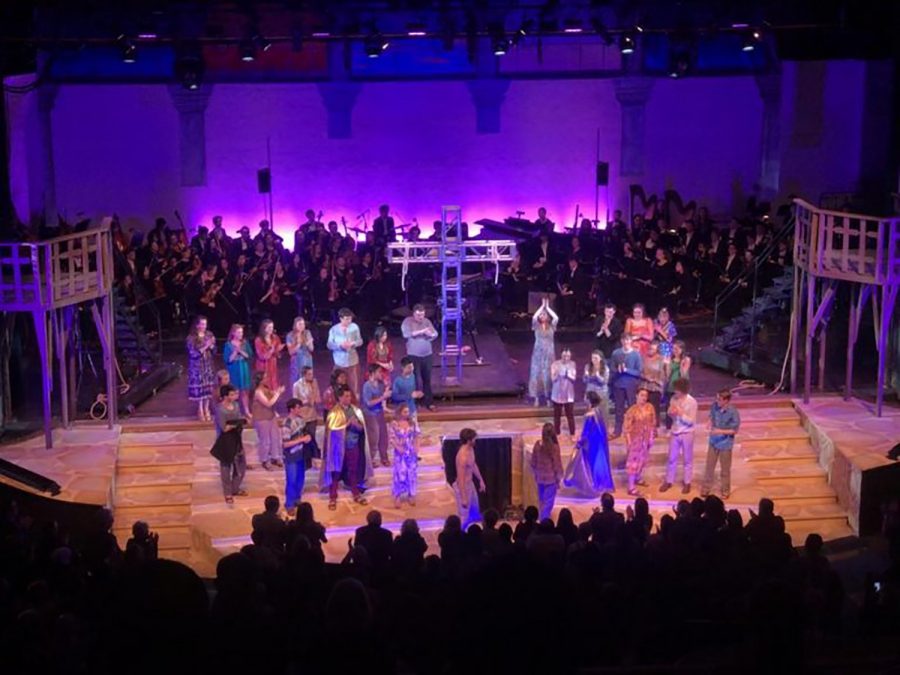‘Jesus Christ Superstar’ pushes the envelope
The play had one of the largest orchestras in NT theater history
The Saturday cast of Choir-Opera’s “Jesus Christ Superstar” takes a bow after their performance
“Jesus Christ Superstar” was unlike any production New Trier’s theater department has taken on in the past. With more students, a larger stage, and more pressure, the show was bigger, flashier, and more complicated than recent New Trier musicals.
Initially, there were concerns about how easily the show could be adapted for a high school stage. Questions arose because “Jesus Christ Superstar” was written for an orchestra much larger than New Trier’s Chamber Orchestra, and the majority of the roles in the show are traditionally played by men.
“About a year ago, we started talking about whether or not we thought we could do it,” David Ladd, the Music and Theatre Department Chair and a director for “Jesus Christ Superstar,” recalled. “There were a lot of considerations to make because the score is a symphonic score and the roles in the show are very male centric. So, we decided if we did the show we would do a more fluid approach to gender.”
Casting decisions were made without strict adherence to the traditional genders of the characters. Ten girls and eight boys were cast (nine total per cast), in contrast to the script, which calls for eight boys and one girl for each cast.
For the musical requirements of the production, the orchestra size nearly doubled from 40 to 87 people. This presented an spacing issue, because an orchestra of that size would not fit comfortably in the pit.
“Instead of it being a 35-40 piece orchestra that can actually fit in the pit, there are 87 members in each of the two orchestras, so the only place that they would really fit is on stage,” Ladd explained.
The decision to put the orchestra on stage for the first time created a very different experience for the members of the orchestra.
From her seat onstage as part of the orchestra, Junior Seorin Park had a front row seat for the show. Park, who usually plays in the symphony orchestra, noticed not only the huge size of the orchestra, but also her proximity to the action.
“I’m physically closer to the actors, so I can see the actors really well and you can also kind of see behind the scenes on stage. Also, there’s more room, which is especially nice because of the extra people,” said Park.
Alongside changing the experience for the cast and orchestra, putting the ensemble on stage also transformed the show for the audience.
“What this did is it allowed us to do these other things; to bring the action and storytelling closer to the audience by building a set over the pit. So instead of an audience member sitting in the front row and still being 20 feet away from the action, they’re within a few feet,” explained Ladd.
A show this spectacular also demands a lot of work, effort and rehearsal from the cast and crew. For junior and keyboard player Grace Yu, she found time management and steady confidence to be essential.
“I think that as a junior, you have to manage your time while also doing this. You have a few months to prepare 20 or so pieces, and I think with the keyboard, because it’s such a solo instrument and it’s not like you’re among 20 violins, it means that you can’t really make a mistake,” said Yu. “[Each] week we have 5 hour rehearsals every day and basically 3-4 hour performances, that’s just a lot of time that is being consumed.”
Junior Alice Hu, who played Bartholomew in the musical, agreed that the time spent rehearsing can be a challenge, and that it was sometimes difficult to maintain a high energy level throughout the whole musical.
“Aside from the time commitment, which I think just hits everyone but we have to find a way to deal with it, the hardest thing is probably building up the stamina for all the songs,” said Hu. “Two of the songs especially are very energy intensive with dancing and singing and everything, and there aren’t really breaks, because they go from one song into another.”
In addition to helping the cast juggle time commitments, practice the songs, and keep up energy the entire time was, Ladd faced challenges of his own.
“It’s interesting; I know the show, I know the story, but the script came with absolutely no directors notes, so I had to completely create how I thought the show should be staged and portrayed,” said Ladd. “And then, after I did that for myself, I had to figure out how I was going to convey my vision to the students so that they understood it, and that was probably the most challenging thing.”
Despite the struggles of the cast, orchestra, and director, they all rose to the challenge and New Trier’s “Jesus Christ Superstar” earned much praise.
“It’s an amazing show,” said Ladd. “The characters are awesome, the music is incredible, it’s such a great story to tell, and it provided so much opportunity for so many students.”







































